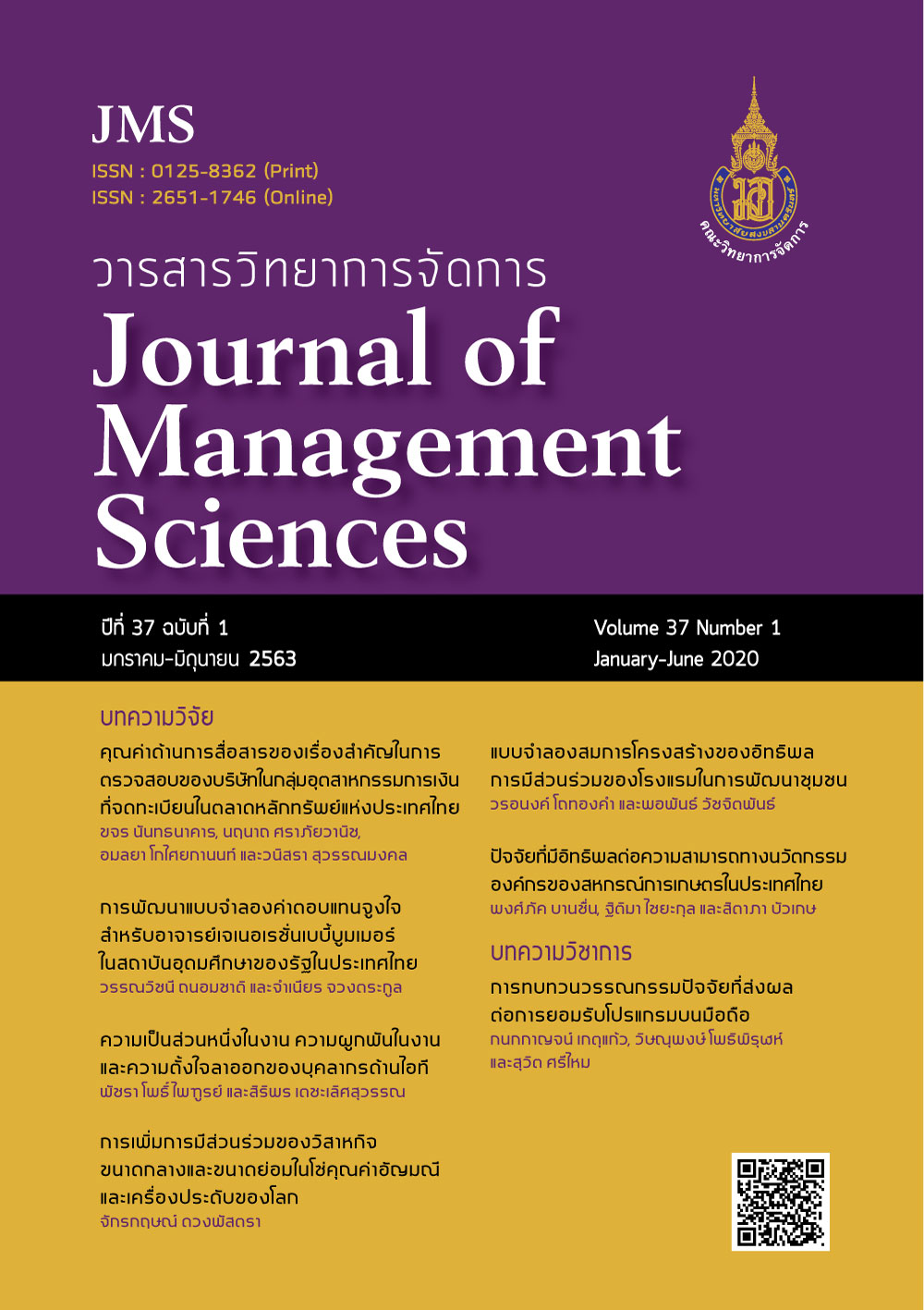การเพิ่มการมีส่วนร่วมของวิสาหกิจขนาดกลางและขนาดย่อมในโซ่คุณค่าอัญมณีและเครื่องประดับของโลก
Main Article Content
บทคัดย่อ
การวิจัยนี้มีวัตถุประสงค์เพื่อศึกษาโอกาส อุปสรรค ปัจจัยแห่งความสำเร็จ และเสนอแนะแนวทางเพิ่มการมีส่วนร่วมของวิสาหกิจขนาดกลางและขนาดย่อมของไทยในโซ่คุณค่าอัญมณีและเครื่องประดับของโลก การวิจัยใช้การวิจัยเชิงผสมผสาน ประกอบด้วยการวิจัยเชิงปริมาณและการวิจัยเชิงคุณภาพ การวิจัยเชิงปริมาณใช้การเก็บข้อมูลด้วยแบบสอบถามจากวิสาหกิจของไทยที่มีประสบการณ์ทำธุรกิจอัญมณีและเครื่องประดับระหว่างประเทศ 70 ราย และการวิเคราะห์ข้อมูลการค้าอัญมณีและเครื่องประดับของไทยและของโลก การวิจัยเชิงคุณภาพใช้การสัมภาษณ์เชิงลึกผู้มีส่วนได้ส่วนเสียในไทยและต่างประเทศ ได้แก่ ผู้ส่งออกไทย 5 ราย ผู้บริหารกิจการเจ้าของตราผลิตภัณฑ์เครื่องประดับชั้นนำของโลก 10 ราย และการจัดประชุมระดมความคิดเห็นในกรุงเทพฯ และต่างจังหวัด จำนวน 4 ครั้ง โดยมีผู้แทนภาครัฐและเอกชนเข้าร่วม 75 ราย
การวิจัยนำข้อมูลจากการวิจัยเชิงผสมผสานมาทบทวนหลายครั้ง เพื่อให้ได้ข้อมูลที่เที่ยงตรง รวมทั้งนำข้อมูลที่มีความหมายคล้ายกันและมีข้อเท็จจริงสนับสนุน เพื่อยืนยันความถูกต้องของข้อมูลที่วิเคราะห์ ผลการวิจัยพบว่า วิสาหกิจขนาดกลางและขนาดย่อมของไทย โดยเฉพาะผู้ผลิตและผู้ค้าพลอย ได้รับโอกาสเข้าสู่โซ่คุณค่าอัญมณีและเครื่องประดับของโลกจากการเติบโตของการผลิตตามความต้องการลูกค้าเฉพาะราย การว่าจ้างให้ผลิตโดยกิจการข้ามชาติที่เป็นเจ้าของตราผลิตภัณฑ์เครื่องประดับ การเปิดตลาดการค้า การให้ความสำคัญกับคุณภาพและมาตรฐานสินค้า และการค้าออนไลน์ ในทางกลับกัน วิสาหกิจขนาดกลางและขนาดย่อมต้องเผชิญอุปสรรคอันเกิดจากการขาดแคลนเงินทุน เทคโนโลยี และทักษะการตลาดระหว่างประเทศ ความผันผวนของราคาและการเข้าถึงวัตถุดิบ การแข่งขันด้านราคา และมาตรการภาษีที่ไม่เอื้อต่อการประกอบการ
ยุทธศาสตร์การเพิ่มการมีส่วนร่วมของวิสาหกิจขนาดกลางและขนาดย่อมของไทยในโซ่คุณค่าอัญมณีและเครื่องประดับของโลกต้องอาศัยความร่วมมือระหว่างภาครัฐและเอกชนในการขับเคลื่อน ประกอบด้วยการเสริมสร้างขีดความสามารถของวิสาหกิจด้วยการพัฒนาคุณภาพการผลิตและมาตรการภาษีให้เอื้อต่อการประกอบการ การสร้างความร่วมมือกับกิจการข้ามชาติ และการสนับสนุนให้วิสาหกิจขนาดกลางและขนาดย่อมเป็นส่วนหนึ่งในการผลักดันให้ประเทศไทยเป็นศูนย์กลางการค้าอัญมณีและเครื่องประดับของโลก
Article Details

อนุญาตภายใต้เงื่อนไข Creative Commons Attribution-NonCommercial-NoDerivatives 4.0 International License.
บทความที่ตีพิมพ์ถือเป็นลิขสิทธิ์ของวารสารวิทยาการจัดการ มหาวิทยาลัยสงขลานครินทร์ อย่างไรก็ตาม กองบรรณาธิการไม่สงวนลิขสิทธิ์ในการทำซ้ำ คัดลอก หรือเผยแพร่ แต่จะต้องอ้างอิงให้ถูกต้องตามหลักวิชาการ
เอกสารอ้างอิง
ASEAN Japan Centre. (2019). Global Value Chains in ASEAN: Thailand, Paper 10. Japan: ASEAN Japan Centre.
DaSilva-Glasgow, D. (2013). Global Value Chain Analysis of Gold Jewellery Industry: Upgrading Tracjectories for Guyana. Guyana: University of Guyana.
Duangphastra, C. (2016). Feasibility Study of Developing Thailand into Global Trade Center of Colored Stone. Bangkok: Office of National Research Commission.
GIT. (2013). Study of Opportunities of Gems and Jewellery Trade in Border Towns. Bangkok: Gems and Jewellry Institute of Thailand (Public Organization).
GIT. (2017). Strategies to Promoting Thailand into Global Production and Trade of Gems and Jewellry. Bangkok: Gems and Jewellry Institute of Thailand (Public Organization).
GIT. (2018). Strategic Plan of Gems and Jewellry Institute of Thailand (Public Organization) 2019-2021. Bangkok: Gems and Jewellry Institute of Thailand (Public Organization).
Gereffi G., & Fernandez – Stark, K. (2011). Global Value Chain Analysis: A Primer. North Carolina: Center on Globalization, Governance and Competitiveness, Duke University.
Li Suhong. (2002). An Integrated Model for Supply Chain Management Practices, Performance and Competitive Advantage. Ohio: University of Toledo.
NESDB (2017). The Twelfth National Economic and Social Development Plan (2017-2021). Bangkok: Office of the National Economic and Social Development Board.
OECD. (2011). Global Value Chains. Preliminary Evidence and Policy Issues. Paris: Trade and Agriculture Directorate, Organization for Economic Co-operation and Development.
OECD. (2012). Mapping Global Value Chains. Paris: Trade and Agriculture Directorate, Organization for Economic Co-operation and Development.
OECD. (2013). Interconnected Economies: Benefiting from Global Value Chain. Paris: Trade and Agriculture Directorate, Organization for Economic Co-operation and Development.
OSEMP. (2017). Cabinet Resolutions Relatetd to SMEs (October 2016 to September 2017). Bangkok: Division of Monitor and Evaluation, Office of Small and Medium Enterprises Promotion.
PWC. (2015). Global Value Chain Integration: A Critical Success Factor in the New Tax Environment. London: PricewaterhouseCoopers.
Sturgeon, T. & Kawakami, M. (2010). Global Value Chain in the Electronics Industry: Was the Crisis a Window of Opportunity for Developing Countries?. Washington, DC: World Bank.
UNCTAD. (2009). Integrating Developing Countries into Global Value Chains. Geneva: United Nations Conference on Trade and Development.
WTO. (2010). Global Value Chain in Changing World. Geneva: World Trade Organization.

